76 Modern Nahua Rituals and Beliefs
Although Tlaloc no longer adorns Nahua temples in modern-day Mexico City, many contemporary religious practices trace back to pre-Columbian times. Water remains a fundamental element in Nahua cosmology and plays an important role in modern rituals. Water continues to fall from the sky, swell riverbanks, form lakes and ponds, helping to connect the sky, earth, and underworld into a cohesive unit. The landscape surrounding Nahua villages continues to influence their cosmology. Every feature of the land, including hills, valleys, springs, and caves, has a proper name and its associated spirit. For the Nahua, our planet is much more than a spherical object that grows crops and sustains life. Earth is itself a powerful spiritual presence with which the Nahua interact daily.
Many modern-day personifications of Nahua weather deities show syncretic-Christian elements brought about after Spaniards and other Europeans colonized the Americas. Some modern Nahua villagers venerate a female fertility deity known as Tonantzin in Nahuatl, meaning “our honored mother.” Scholars have identified Tonantzin as a pre-Columbian fertility deity that, over time, came to be associated with the Virgin Mary. Consequently, Tonantzin transformed into the, now famous, Virgin of Guadalupe of Mexico.
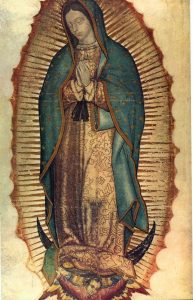
According to a seventeenth-century Nahuatl text entitled Nican Mopohua, the Virgin Mary appeared to an Indigenous Chichimec peasant named Juan Diego four times. After the final apparition, Juan Diego opened his cloak to find the above image of Mary miraculously imprinted on the fabric.
It is important to refrain from viewing the Virgin Mary’s use among the Indigenous peoples of Mexico simplistically as a “win” for the Catholic Church and a “loss” for Native Americans like the Nahua. For many modern Nahua, Tonantzin offers a valuable link between Christianity and the pre-Columbian Nahua traditions of antiquity. Modern Nahua ritual specialists have created their own syncretic cosmology which continues to emphasize duality and reciprocity. Many modern Nahua ritual specialists believe Tonantzin originated from the sky but then moved to Earth of her own accord. She now inhabits the sacred caves and peaks in the mountains. Tonantzin watches over the village and brings fertility to humans and their crops. A statue of the Virgin of Guadalupe (now synonymous with Tonantzin) is often housed at local shines in Nahua villages. Offerings of food are made so that the Virgin Mary (aka Tonantzin) remains content and continues to protect the community.
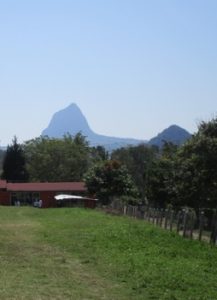
Today, the Virgin protects Nahua villagers provided they satisfy her “needs” with devout prayers and other offerings, showing the continued need for reciprocity. Aztec rituals in the Templo Mayor similarly focused on reciprocity through offerings of food as well as the appropriate words or prayers. Recall that in spring, the Aztecs traditionally revered Tlaloc by dedicating shines to him throughout central Mexico.
Modern anthropological studies shed light on other continuities in Nahua religion, albeit infused with postconquest elements. Many Nahua peoples believe Tonantzin displayed her fertility by having several children. One popular Nahua myth is that Tonantzin gave birth to four sons: Tlahuelilo, Sa Hua (derivative of San Juan {Eng. Saint John}), Montezuma (the famous Aztec emperor), and Toteotzin, who in this Christianized lens is Jesus Christ. Toteotzin translates from Nahuatl to “our honored god” in English. Toteotzin rules from the sky. In pre-Hispanic times, the underworld was called Mictlan in Nahuatl. Mictlan translates to “land of the dead.” Tlahuelilo was known to have originated from the “land of the dead” or Mictlan in Nahuatl.
Rather than revere Tlaloc as in pre-Hispanic times, many modern Nahua believe Sa Hua (Saint John in English) to be a water spirit who sends the rain from his home in the sea. Montezuma is an earth-realm deity who can miraculously construct both pre-Hispanic ruins and Catholic churches. Because Toteotzin, the sun-Christ (or “our honored god” in English) who rules from the sky, was born last, he holds less power than his mother (Tonantzin) and his elder brothers. In modern Nahua cosmology, Tonantzin’s fertility takes precedence over the sun-Christ’s power to warm the earth.
Pre-Columbian notions of reciprocity and their role in fertility show themselves to remain important in modern times. We see that rain deities (or spirits) like Sa Hua (Eng. Saint John) inhabit the landscape as in pre-Columbian times. Moreover, fertility and reproductivity seem to directly relate to the sun in similar ways, emphasizing the importance of duality.
Recall that the Aztec peoples of Tenochtitlan (today’s Mexico City) dedicated their Templo Mayor to a pair of gods: Huitzilopochtli (war deity) and Tlaloc (the aforementioned weather deity). The temple contained a dual staircase, with two symmetrical shrines atop. One deity directly influenced another in the daily struggle to maintain cosmic equilibrium. One Aztec myth highlights gender by pairing the male war god Huitzilopochtli with a female relative named Coyolxauhqui to explain the moon’s existence.
There are several versions of the gruesome battle and violence that take place between Huitzilopochtli and Coyolxauhqui as familial rivals. In some versions, Huitzilopochtli and Coyolxauhqui were siblings. In other myths, these two deities were related as mother and son. Regardless of which version one encounters, Huitzilopochtli emerged victorious by dismembering and decapitating Coyolxauhqui. In many versions, Coyolxauhqui’s head was tossed into the sky, thus becoming Earth’s moon.
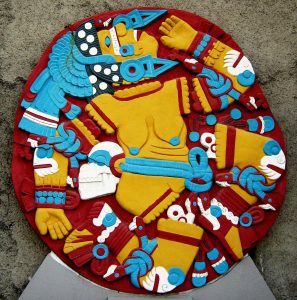
Through their rituals, offerings, and words, humans might tilt the divine scale one way or the other. As the Aztec spiritual leaders (tlaloqueh in Nahuatl) ascended and descended the steps of the Templo Mayor in Tenochtitlan, they retold and reaffirmed their culture and identity as an ethnic group. Passing by the circular stone of Coyolxauhqui would have necessitated reflection on the moon and its place in the cosmos. Huitzilopochtli’s shrine at the top of the pyramid in conjunction with Coyolxauhqui’s stone at the base of a staircase reemphasized the pairing of these two deities and the importance of duality.
In addition to war, Huitzilopochtli may also have been associated with the sun, or daytime more broadly. Certain scholars maintain that Coyolxauhqui’s battle with Huitzilopochtli also explained why the day and night exist. The day (Huitzilopochtli in this instance) fought for its existence against night, the eternal rival. Huitzilopochtli and Coyolxauhqui represented the sun and moon thought to form a natural pair. Such symbolism can extend to the day and night so that Huitzilopochtli and Coyolxauhqui also symbolized the daytime and nighttime.
Although modern Nahua peoples remain nominally Catholic, duality remains prevalent in village festivities, including that of Carnival. Catholics around the world celebrate Carnival (Mardi Gras in New Orleans, USA) in February because it is a Western Christian festive season that takes place before the celebration of Lent. Lent is the period preceding Easter, which is devoted to fasting and penitence in recognition of Jesus Christ’s fasting in the wilderness (Matthew 4:2) in March or April, depending on the year. Carnival and Lent thus have deep associations with the agricultural cycle as well, through the symbolism of “fattening” oneself for the lean times ahead.
Native peoples in Chicontepec, Veracruz celebrate Carnival and have infused these festivities with Nahua notions of duality. Beginning on Fat Tuesday (Mardi Gras in French), groups of Nahua men come together to dance, play music, and give thanks for the coming year. In the picture below, Nahua men play traditional folk music on a guitar and violin. Two “friendly” devils can be seen in red and black. Duality is maintained as the red devil is cosmologically tied to the devil in black. Look at the dancers for a moment. You may notice another point of duality as the “women” (biological Nahua men wearing feminine masks, wigs, and outfits) dancers are paired evenly with their male counterparts. An odd number of dancers would be inappropriate.
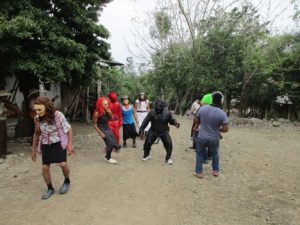
In the above photo, the male dancers keep to one side (right) while the “female” dancers keep to the other (left in this instance). Doing so helps maintain cosmological equilibrium, but the devils, as supernatural beings, are allowed to travel to either side should they choose to do so. Here, the black devil is posing for the camera while the red devil watches from the feminine side. The villagers of Chicontepec provide additional cash offerings for dances if the group successfully impresses their audience. If the viewers are not impressed, they will not ask for more dances and the group leaves.
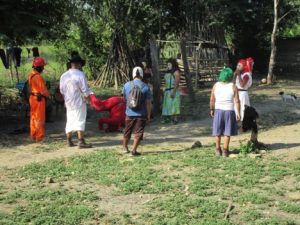
Gender in Agrarian Villages
Patriarchy continues to influence villages in Mexico, shaping the lives of everyday Nahua men and women in Veracruz. Attentive readers may have noticed the above photos show very broad-shouldered, muscular “women” wearing wigs and dresses. Indeed, the Nahua group discussed above consisted entirely of biological men. However, because duality remains important in Nahua areas, an even number of biological men adorn wigs, masks, and dresses to dance with their male counterparts. Symbolically, gender symmetry between men and women is maintained in this way as an even number of “women” dance with an even number of men.
You may wish to know why modern-day Nahua women simply don’t accompany their menfolk so that the men need not dress as women. Assuming this to be the case, we ask that you pause to consider the potential ramifications for young Nahua women galivanting from one neighborhood to another with a group of men during Carnival. An internal regulatory mechanism remains in play in many Nahua villages, that of scandal. Were young Nahua women to accompany a raucous group of men during these dances at Carnival, it would likely cause scandal for their families as locals gossiped about their “loose” or “immoral” behavior. This particular view of gender means that the biological males travel from one place to another, leaving Nahua women confined to their houses or natal villages. This restriction of movement helps to avoid scandal.
Final Remarks
Many Nahua peoples in Mexico continue to revere nature and hold that duality is key for fertility. Recent scholarship by the Nahua anthropologist Abelardo de la Cruz de la Cruz highlights the importance of fertility in everyday Nahua rituals, from planting corn seeds to cooking food. If you would like to know more about Native Americans such as the Nahua, have a look at the following pages.
